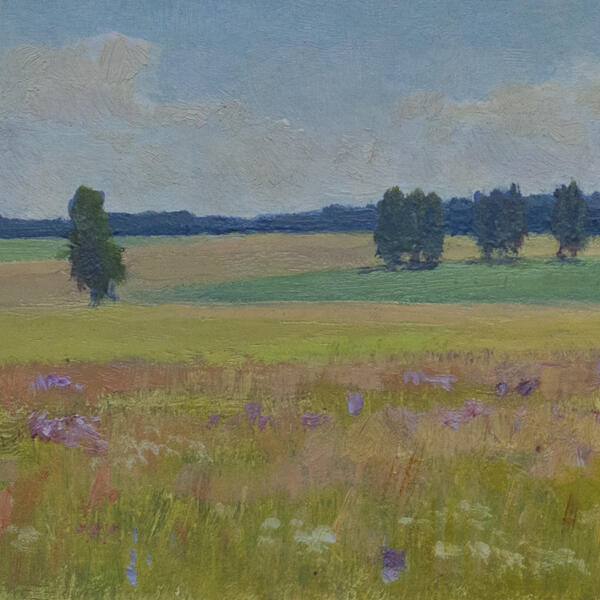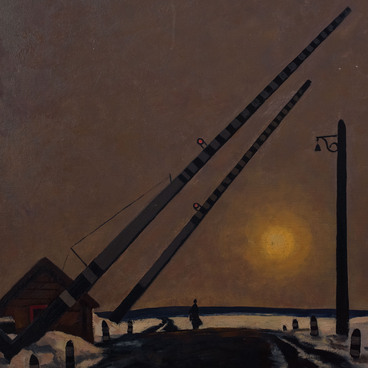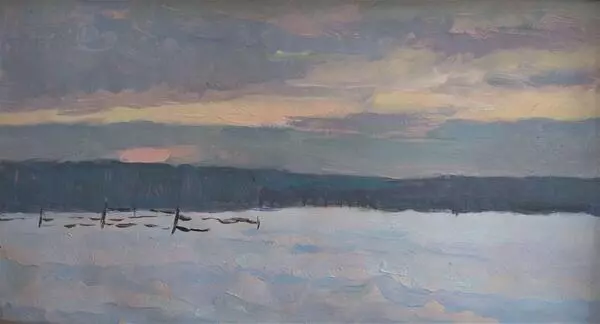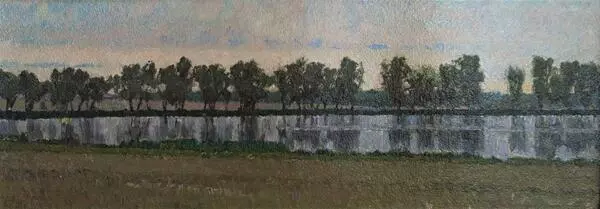The Volzhsk Art Gallery collection contains Serafim Zverev’s painting “Sunlit Meadow”, which was painted in the mid-20th century. This multilayered landscape has an unusual narrowband format, only nine centimeters in height, resembling a panorama.
In this picture, Zverev depicted a meadow with many full-blown flowers. Further off is a yellow field with a bright green headland of another meadow, where the plants have not bloomed yet. This field has single trees with lush crowns. A vast forest belt darkles at the far-distance view. The sunlit landscape is depicted side by side with the pale blue sky with semi-translucent clouds.
In this artwork, the horizon line is the structural centerpiece that maintains the compositional and color balance of the painting. This line also represents the concept of the landscape and produces two opposite effects — moving beyond the horizon and at the same time moving towards it.
The middle ground is counted not from the middle of the canvas but from the horizon. In many of his early landscape studies, Zverev deliberately omitted the foreground, achieving maximum generalization and homogeneity of space.
Serafim Zverev was a painter, graphic artist, mosaic artist, and a talented copyist. He created mosaic panel pictures at the Komsomolskaya-Koltsevaya metro station, made cardboards for mosaics in the Moscow State University events hall and the high-rise building on Vosstaniya Square, and easel portraits of the theoretical physicist Nikolay Umov, the geologist Vasily Dokuchayev, and others for the new Moscow State University building.
However, the landscape has always been Zverev’s favorite genre. By the 1960s, the artist had developed his own work pattern. He went out sketching to Crimea, Siberia, the Urals, or the Moscow suburbs, and then spent years in his studio finishing the studies and pencil drawings he made there. He considered each drawing as a sketch for a new landscape composition.
Serafim Zverev painted until his death. In the decline of years, he practically stayed at home and used a wheelchair. Zverev died in 1979, in Moscow. A piece of paper was found in the artist’s documents where he wrote,
In this picture, Zverev depicted a meadow with many full-blown flowers. Further off is a yellow field with a bright green headland of another meadow, where the plants have not bloomed yet. This field has single trees with lush crowns. A vast forest belt darkles at the far-distance view. The sunlit landscape is depicted side by side with the pale blue sky with semi-translucent clouds.
In this artwork, the horizon line is the structural centerpiece that maintains the compositional and color balance of the painting. This line also represents the concept of the landscape and produces two opposite effects — moving beyond the horizon and at the same time moving towards it.
The middle ground is counted not from the middle of the canvas but from the horizon. In many of his early landscape studies, Zverev deliberately omitted the foreground, achieving maximum generalization and homogeneity of space.
Serafim Zverev was a painter, graphic artist, mosaic artist, and a talented copyist. He created mosaic panel pictures at the Komsomolskaya-Koltsevaya metro station, made cardboards for mosaics in the Moscow State University events hall and the high-rise building on Vosstaniya Square, and easel portraits of the theoretical physicist Nikolay Umov, the geologist Vasily Dokuchayev, and others for the new Moscow State University building.
However, the landscape has always been Zverev’s favorite genre. By the 1960s, the artist had developed his own work pattern. He went out sketching to Crimea, Siberia, the Urals, or the Moscow suburbs, and then spent years in his studio finishing the studies and pencil drawings he made there. He considered each drawing as a sketch for a new landscape composition.
Serafim Zverev painted until his death. In the decline of years, he practically stayed at home and used a wheelchair. Zverev died in 1979, in Moscow. A piece of paper was found in the artist’s documents where he wrote,





